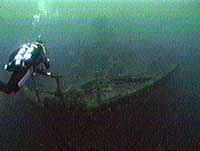|
|
|
|
| Missing In Action (MIA) | Prisoners Of War (POW) | Unexploded Ordnance (UXO) |
| Chronology | Locations | Aircraft | Ships | Submit Info | How You Can Help | Donate |
|
| IJN Freighter Auxiliary General Transport Repair Ship 5,110 Tons 422' length  Andrew Wright 1994 |
Ship History Built by by Tama Zosensho. Laid down May 21, 1938 as a 5,110 ton freighter for Itaya Shosen K. K. in Tokyo. Launched November 12, 1938 as Hakkai Maru. Completed February 21, 1939 and placed into commercial service by Itaya Shosen K. K. Wartime History On March 26, 1941 requisitioned by the Imperial Japanese Navy (IJN) and registered in the Sasebo Naval District as an auxiliary general transport. On June 24, 1942 begins conversion into a repair ship at Sasebo Naval Yard. On August 12, 1942 the conversion was complete. On September 1, 1942 departs Sasebo bound for Simpson Harbor off Rabaul to repair damaged warships and vessels. On October 1, 1942 placed under the command of recalled Captain Tokujiro Yokoyama. On October 2, 1942 begins repairs to bomb damaged Tenryu. On October 14, 1943 begins repairs to bomb damaged Kiyokawa Maru. On October 20, 1942 completes repairs on Tenryu. PARTIAL HISTORY The Hakkai Maru was making repairs to a Japanese cruiser near New Georgia and until sunk by Allied bombers. Afterwards departed for Rabaul. Sinking History On January 17, 1944 at 10:55am hit by a TBF Avengers armed with 2,000 pound bomb that made glide bombing attack at low level. The bomb explodes in the engine room and killed 25 aboard (23 gunners and 2 crew) and caused flooding. Around noon, sinks stern first in Simpson Harbor off Rabaul at roughly Lat 4° 13' S Long 152° 15' E. On March 10, 1944 officially removed from the Navy list. Shipwreck Hakkai Maru came to rest upright on a sloping seafloor, with her stern at 80' and her bridge at 100'. Beautiful coral growth covered her superstructure, king post and hull. The stern had the coral encrusted anti-aircraft gun. The cargo holds are full of machinery. drills, lathes, presses, welders, and every imaginable type of metal working machines lined the decks with everything from hull plates to torpedoes. During the 1960–1970s, a number of relics collected by divers from the wreck are displayed at the Kokopo War Museum, including the ship's clock, stopped at 5:40pm, the moment the ship sank. A diver decompression chamber was bolted to the fore deck measuring 5' long and 10' wide, including nickel etched dive tables bolted inside. In 1971, an unsuccessful salvage attempt was made to recover the chamber, documented by a Japanese film crew. Later, salvaged by diver Jim Forrest and abandoned at Pat Robert yard along Blanch Bay where it remained until the 1980s. Ultimate fate unknown, likely scrapped or otherwise disappeared. During the 1994 volcanic eruptions at Rabaul, the shipwreck was covered in ash, and is no longer able to be dived. References Sometimes incorrectly spelled Hachikai Maru which was the name of an auxiliary gunboat Combined Fleet: IJN Repair Ship HAKKAI MARU: Tabular Record of Movement National Geographic "Ghosts of War In the South Pacific" page 435 - 436 Winged Ghosts of the South Pacific dives this wreck The Last New Guinea Salvage Pirate (2006) pages 134-136 Contribute
Information |
80–100' |
| Discussion Forum | Daily Updates | Reviews | Museums | Interviews & Oral Histories |
|